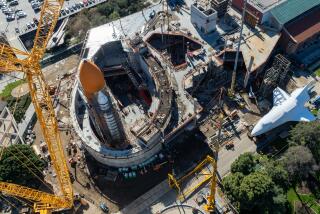Endeavour’s Astronauts End Earth-Mapping Work
- Share via
KENNEDY SPACE CENTER, Fla. — Astronauts aboard the space shuttle Endeavour ended their ambitious Earth-mapping work Monday after some anxious moments closing a hatch. Bad weather forced them to consider landing at a seldom used strip in New Mexico.
Following a final mapping pass over Australia, the astronauts began to stow their equipment for today’s scheduled landing, but there was trouble with the 20-story radar mast deployed just hours after their Feb. 11 liftoff.
Although the 197-foot collapsible truss-structure folded easily into its canister in Endeavour’s cargo bay, three latches designed to secure the canister’s hatch refused to lock into place.
The Endeavour astronauts, working remote controls from the orbiter’s crew compartment, tried three times to shut the lid before finally succeeding. Cheers erupted in Houston’s Mission Control Center when ground controllers saw the hatch close successfully in a television feed from the orbiter.
If the astronauts had not been able to close the hatch, Mission Control probably would have ordered them to detonate small explosives that would have tossed the mast and its canister overboard.
Even if the mast had been sacrificed, the glitch would not have affected the focus of Endeavour’s mission, collecting radar readings that will be used to create the most detailed 3-D surface maps ever assembled.
A concern was raised later Monday when NASA said weather looked bad for landing at the Kennedy Space Center in Florida and was forecast to get worse at an alternative landing site in California. That might force Endeavour to aim for a seldom used landing strip at White Sands, N.M., NASA said.
Astronauts use the strip for practice landings in their training jets, but only one shuttle mission has landed there--in the early 1980s--and budget cutbacks have left the facility ill-equipped to process Endeavour after landing. Still, an official said the space agency had no qualms about using White Sands and would fly in the technicians and equipment if needed.
Since taking flight, the shuttle has mapped more than 46 million square miles of the Earth’s land formations, most of it twice. The data was stored on 326 digital cassettes.
More to Read
Sign up for Essential California
The most important California stories and recommendations in your inbox every morning.
You may occasionally receive promotional content from the Los Angeles Times.













